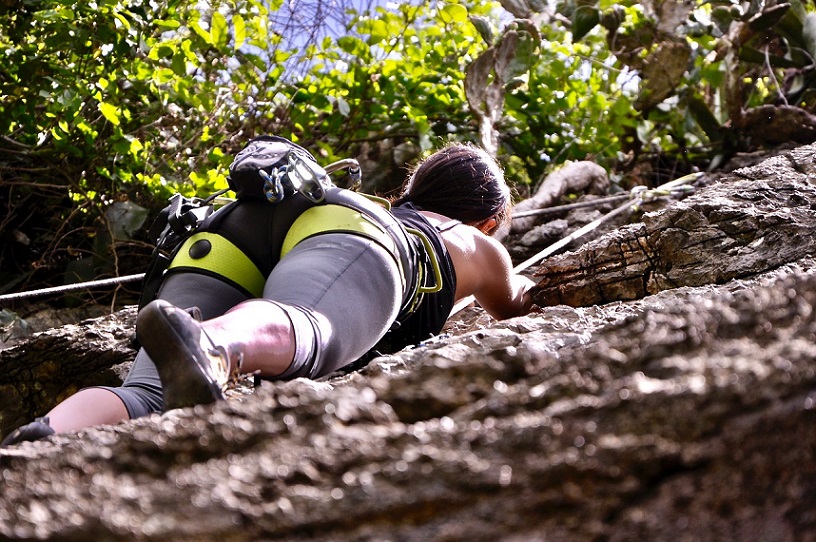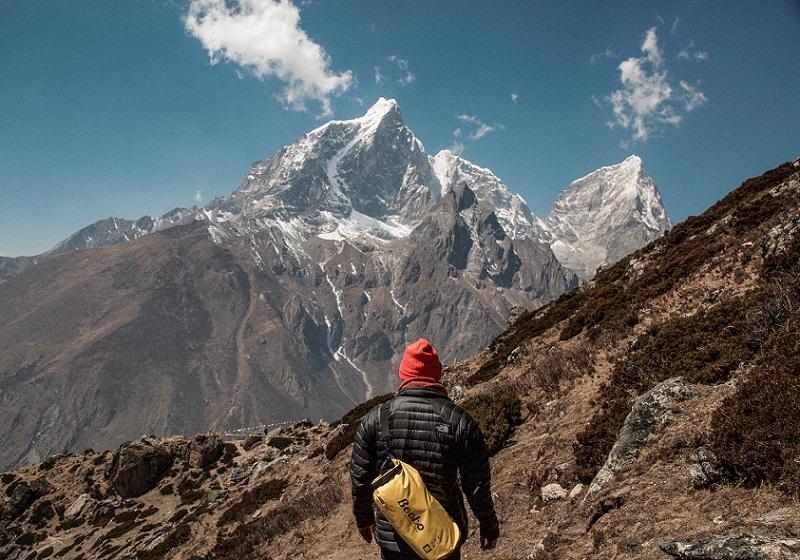Is fear holding you back from rock climbing?
If so, I can’t really say I blame you. For those who’ve never gone rock climbing before, it can appear to be an extremely dangerous sport.
I mean, there’s nothing safer than dangling hundreds of feet in the air, right?
But, all jokes aside, how dangerous is rock climbing?
Is your fear of rock climbing justified, and should you let it keep you from trying it out?
The answer isn’t so simple.
As a rock climber myself, I must admit that the sport can be dangerous.
But with modern technology and techniques, it’s hardly the most dangerous sport out there.
And while it’s true that proper techniques and equipment make rock climbing relatively safe, it’s important to note that climbing itself poses danger.
Don’t get me wrong: this isn’t intended to discourage anyone from rock climbing. But any discussion of the safety of rock climbing would be remiss without being honest. And it’s from my experience that it’s people who don’t appreciate how inherently dangerous rock climbing is who end up getting hurt.
As a general rule of thumb, consider this:
The less you appreciate the danger of rock climbing, the less safe it becomes.
It’s also important to note that there are several factors that can influence the safety of your climb. Under the right conditions, you should expect to rock climb without any major concerns.
And to a large extent, the safety of your rock climb is up to you.
Let’s take a look at the various factors that can affect the safety of your climb:
Statistical Overview of Rock Climbing Accidents
There’s perhaps no better way to get a surface-level view of the safety of rock climbing than a look at the statistics.
Unfortunately, public data on rock climbing injuries is rather sparse.
The truth is that it can be difficult separating real rock climbing fatalities from the deaths of individuals in rock climbing situations.
It’s even more difficult to come by data on non-fatal rock climbing injuries.
So, what do we know?
What they found was that of all 2,198 mountain and wilderness victims rescued during this time, only 428 were rock climbers. This averages to right at 30 people a year.
Keep in mind that this number includes more than fatalities. However, the study neglects to detail how serious the injuries were to each individual.
What we do know is that 43% of them were “stranded or lost,” suggesting that they weren’t injured, leaving only 244 injuries during this period—an average of 17 injured a year.
More tellingly, only 23 fatalities were reported during these fourteen years—nine being from unroped falls. In fact, 42% of all rock climbing victims participated in unroped climbing.
In total, 12% of accidents were due to belaying problems and 4.5% came from falls, and the most common injuries came to the lower body (29.5%).
So what does this data tell us?
For starters, it must be noted that the data represented here is only one small subsection of national data for the US. From this data, it would be impossible to represent global or even national safety levels. With that in mind, however, it shows that rock climbing is relatively safe.
However, as noted, this provides only a surface-level overview of the situation.
To really understand how dangerous rock climbing is or will be for you, we’ll need to examine the particulars.

The Role of Your Experience Level
Perhaps the most important determinant behind the safety of rock climbing is the climber’s experience level.
Generally speaking, the less experienced you are, the more dangerous the climb will be.
Why?
This is true for several reasons.
Namely, those with less experience do not have a proper grasp on technique. This can affect the safety of the climb in various ways.
From properly setting up equipment to belaying in a safe manner, technique can make or break the safety of your climb.
Even the smallest belaying mistake can prove fatal when rock climbing.
And because climbers are also at the mercy of their belayers, it’s important that everyone involved has proper experience. Even if you are experienced, for instance, partnering with an amateur belayer can cause serious accidents.
In fact, that same Colorado study found that 20% of accidents could have been prevented if the belayers had used better techniques.
Case in point: don’t underestimate the power of experience.
If you’re looking to get into rock climbing, this information probably comes as no consolation. If the most dangerous time to climb is when you first start out, it can be difficult getting started.
But don’t let that scare you away. If you’re truly passionate about starting rock climbing, consider taking courses with experienced instructors. By putting yourself in the right environment, you can learn and gain experience in a safe and effective manner.
By the time you’re ready to move on to climbing, you can find experienced partners to show you the ropes.
Just keep one thing in mind:
Having experience doesn’t always mean that the climb is going to be safe.
Sometimes, even the most-experienced climbers will have accidents due to negligence.
That’s right—it’s all-too-common that experienced climbers get too complacent with their rock climbing techniques.
It’s likely that they’ve picked up bad habits over the years. And, as humans, it’s easy to keep performing an action if we haven’t seen any consequences.
The thing about rock climbing, however, is that these actions aren’t worth taking. Though you may get away with a bad habit for a number of years, if—or when—it catches up to you, you might not get a second chance.
For this reason, make sure that no matter your skill level, you’re staying focused on the safety of your climb.
Don’t forsake proper technique for shortcuts. Don’t ever assume it will be okay just because it’s worked before.
Always remember that rock climbing is dangerous without the proper equipment and techniques. By remaining focused on safety every step of the way, you can significantly reduce the chance for accidents. And by finding a partner who is similarly-concerned with safety, you can all but eliminate the chance of serious injury or death.
Proper Techniques and Equipment
So, just how important is it that you use the proper techniques and equipment?
Take a look at statistics compiled by the American Alpine Club. The study recorded rock climbing accidents from the US from the early 1950s to 2012. Though it can be assumed that the actual statistics are higher (because injuries must be self-reported to the American Alpine Club), there is an established trend in the data.
For example, the number of accidents was the lowest in the 1950s, with the number steadily rising until peaking in the 1990s.
This is to be expected, as the number of individuals involved in rock climbing grew exponentially during this time.
Since the 1990s, however, there’s been a steady decrease in the number of injuries, with the number of deaths hitting nearly forty-year lows.
With rock climbing participation staying steady or growing over these years, it can only be reasoned that proper technique and advancements in equipment have made the sport safer.
In fact, the number of deaths in the US hasn’t been reported to be 50 or higher in a single year since the 1970s.
For this reason, it’s important to make sure that proper equipment and techniques are being used.
And as seen from the Colorado study, make sure that the equipment is being used correctly. Failure to setup equipment correctly is the leading cause of equipment failure.
If you’re unsure if your equipment is correct, make sure to take time to learn from a professional. Importantly, never climb until you’ve made sure that your setup is correct. Verify it with your partner before starting your climb.
So what’s the bottom line here?
When it comes to your rock climbing safety, much of it depends on you. Make sure that you’re following proper protocol to enjoy as safe a climb as possible.
We’ve seen that failure to do so often results in serious injury or death, so be sure to keep your safety your top priority.
In doing so, you’re likely to avoid any major injuries.
Definition of Dangerous
It’s difficult to say how dangerous rock climbing is without first defining dangerous.
If you’re worried about life-changing accidents and death, then you can reasonably expect to avoid both with proper practices.
However, if you’re looking to not get hurt at all, rock climbing may not be the sport for you.
Even small falls can lead to bruising and twisted ankles—and to a million things in between. Though these aren’t dangerous in the sense that they’ll permanently alter or end your life, they can be a nuisance.
It’s difficult to find data on the number of small rock climbing accidents because they often go unreported.
One can be reasonably certain that these issues also usually stem from malpractice, but even still, they’re likely unavoidable.
Many rock climbers, for instance, will develop painful “flappers” of torn skin where callouses have been broken or torn off. This can be quite painful, but does it qualify as “dangerous”?
That likely depends on your definition.
Before starting rock climbing, be prepared to get your fair share of flappers, cuts, and bruises. With the proper technique, however, it’s unlikely that you should fear anything more.
Terrain
Another reason that it’s so hard to classify how dangerous rock climbing is, is because it sometimes depends on the terrain being climbed.
For example, the Colorado study found that accidents caused by climate changes accounted for nearly 5% of the total number. These came from rocks that had been loosened during the freeze and thaw cycles of spring. Likewise, some had been overused by other climbers.
Because of this, it’s important that each climber take the time to appropriate evaluate the terrain before attempting to make the climb.
By taking each step with caution, a climber can better ensure his or her own safety.
Type of Rock Climbing
Finally, the safety of your climb depends largely on the type of climbing that you’re doing.
For example, those climbing indoors generally have a safer experience than those outside. And even then, boulderers are much less likely to be injured than alpine or ice climbers.
For this reason, it’s important to note the distinctions between each type. If you’re just looking for a moderate thrill, climbing indoors is a safe and effective way to do that.
While indoor climbing doesn’t eliminate risks, it can significantly reduce them. Though any height over 30 feet (9 meters) can be fatal, indoor gyms are better equipped to provide proper protection in case of a fall.
For instance, the surface below might be soft enough to cushion the fall, or special safety equipment might be provided to help make it safer.
When outdoors, however, a fall of this height will often prove fatal. Instead of potentially hitting a soft surface, you’re going to crash into the cold, hard ground—that is assuming there’s a problem with your belayer. Most individuals who fall are caught with minimal harm.
Those who do specialized alpine or ice climbing are at an increased risk of falls, making them comparatively more dangerous.
The Bottom Line
So, is rock climbing dangerous?
Yes, but it doesn’t have to be.
By making sure that you and your partner are adhering to proper safety techniques, you can effectively make rock climbing safer than driving a car.
However, because there is inherent danger in the sport, mistakes and inexperience can sometimes be fatal. By keeping this in mind, you can better prepare yourself and use the right techniques that will keep you safe.
In the end, you’re only as safe as you allow yourself to be.
With this in mind, don’t be afraid to give rock climbing a go. With the right approach, you can confidently expect to climb safely every time.







Hello Alex, thanks for this post. It really answers questions that a lot of people who are afraid to try it. Its nice to let the people know that it is safe and fun.
Hey there Lydia! Thank you for taking the time to comment on my brand new blog! You’re actually the first to comment, so I really appreciate it 😉 Glad you liked this post!